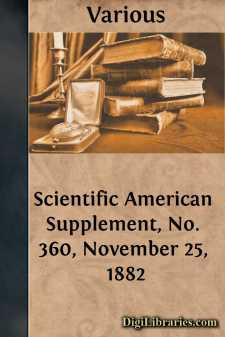Categories
- Antiques & Collectibles 13
- Architecture 36
- Art 48
- Bibles 22
- Biography & Autobiography 813
- Body, Mind & Spirit 142
- Business & Economics 28
- Children's Books 17
- Children's Fiction 14
- Computers 4
- Cooking 94
- Crafts & Hobbies 4
- Drama 346
- Education 46
- Family & Relationships 57
- Fiction 11829
- Games 19
- Gardening 17
- Health & Fitness 34
- History 1377
- House & Home 1
- Humor 147
- Juvenile Fiction 1873
- Juvenile Nonfiction 202
- Language Arts & Disciplines 88
- Law 16
- Literary Collections 686
- Literary Criticism 179
- Mathematics 13
- Medical 41
- Music 40
- Nature 179
- Non-Classifiable 1768
- Performing Arts 7
- Periodicals 1453
- Philosophy 64
- Photography 2
- Poetry 896
- Political Science 203
- Psychology 42
- Reference 154
- Religion 513
- Science 126
- Self-Help 84
- Social Science 81
- Sports & Recreation 34
- Study Aids 3
- Technology & Engineering 59
- Transportation 23
- Travel 463
- True Crime 29
Scientific American Supplement, No. 360, November 25, 1882
by: Various
Categories:
Description:
Excerpt
When Sir Henry Bessemer, in 1856, made public his great invention, and announced to the world that he was able to produce malleable steel from cast iron without the expenditure of any fuel except that which already existed in the fluid metal imparted to it in the blast furnace, his statement was received with doubt and surprise. If he at that time had been able to add that it was also possible to roll such steel into a finished bar with no further expenditure of fuel, then undoubtedly the surprise would have been much greater.
Even this, however, has come to pass; and the author of this paper is now pleased to be able to inform this meeting that it is not only possible, but that it is extremely easy and practical, by the means to be described, to roll a steel ingot into, say, a bloom, a rail, or other finished article with its own initial heat, without the aid of the hitherto universally adopted heating furnace.
It is well understood that in the fluid steel poured into the mould there is a larger store of heat than is required for the purpose of rolling or hammering. Not only is there the mere apparent high temperature of fluid steel, but there is the store of latent heat in this fluid metal which is given out when solidification takes place.
It has, no doubt, suggested itself to many that this heat of the ingot ought to be utilized, and as a matter of fact, there have been, at various times and in different places, attempts made to do so; but hitherto all such attempts have proved failures, and a kind of settled conviction has been established in the steel trade that the theory could not possibly be carried out in practice.
The difficulty arose from the fact that a steel ingot when newly stripped is far too hot in the interior for the purpose of rolling, and if it be kept long enough for the interior to become in a fit state, then the exterior gets far too cold to enable it to be rolled successfully. It has been attempted to overcome this difficulty by putting the hot ingots under shields or hoods, lined with non-heat-conducting material, and to bury them in non-heat-conducting material in a pulverized state, for the purpose of retaining and equalizing the heat; but all these attempts have proved futile in practice, and the fact remains, that the universal practice in steel works at the present day all over the world is to employ a heating furnace of some description requiring fuel.
The author introduced his new mode of treating ingots at the Darlington Steel and Iron Company's Works, in Darlington, early in June this year, and they are now blooming the whole of their make, about 125 tons a shift, or about 300 ingots every twelve hours, by such means.
The machinery at Darlington is not adapted for rolling off in one heat; nevertheless they have rolled off direct from the ingot treated in the "soaking pits" a considerable number of double-head rails; and the experience so gained proves conclusively that with proper machinery there will be no difficulty in doing so regularly. The quality of the rails so rolled off has been everything that could be desired; and as many of the defects in rails originate in the heating furnace, the author ventures to predict that even in this respect the new process will stand the test.
Many eminently practical men have witnessed the operation at Darlington, and they one and all have expressed their great surprise at the result, and at the simple and original means by which it is accomplished.
The process is in course of adoption in several works, both in England and abroad, and the author hopes that by the time this paper is being read, there may be some who will from personal experience be able to testify to the practicability and economy of the process, which is carried out in the manner now to be described....












